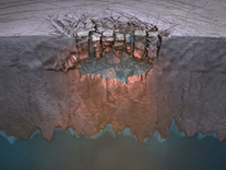Water Under Europa's Ice
 Europa's "Great Lake." Scientists speculate many more exist throughout the shallow regions of the moon's icy shell.
Image Credit: Britney Schmidt/Dead Pixel FX/Univ. of Texas at Austin.
Europa's "Great Lake." Scientists speculate many more exist throughout the shallow regions of the moon's icy shell.
Image Credit: Britney Schmidt/Dead Pixel FX/Univ. of Texas at Austin.
 Thera Macula (false color) is a region of likely active chaos production above a large liquid water lake in the icy shell of Europa. Color indicates topographic heights relative to background terrain. Purples and reds indicate the highest terrain.
Image Credit: Paul Schenk/NASA.
Thera Macula (false color) is a region of likely active chaos production above a large liquid water lake in the icy shell of Europa. Color indicates topographic heights relative to background terrain. Purples and reds indicate the highest terrain.
Image Credit: Paul Schenk/NASA.
 Europa, from NASA's Galileo spacecraft. Visible are plains of bright ice, cracks that run to the horizon, and dark patches that likely contain both ice and dirt.
Image Credit: NASA
Europa, from NASA's Galileo spacecraft. Visible are plains of bright ice, cracks that run to the horizon, and dark patches that likely contain both ice and dirt.
Image Credit: NASA
The water could represent a potential habitat for life, and many more such lakes might exist throughout the shallow regions of Europa's shell, lead author Britney Schmidt, a postdoctoral fellow at The University of Texas at Austin's Institute for Geophysics, writes in the journal Nature.
The scientists focused on Galileo spacecraft images of two roughly circular, bumpy features on Europa's surface called chaos terrains. Based on similar processes seen here on Earth - on ice shelves and under glaciers overlaying volcanoes - the researchers developed a four-step model to explain how the features form on Europa.
The data suggest there is significant exchange between Europa's icy shell and the ocean beneath. This information could bolster arguments that Europa's global subsurface ocean represents a potential habitat for life elsewhere in our solar system.
One of the most significant discoveries was the inference of a global salt water ocean below the surface of Europa. This ocean is deep enough to cover the whole surface of Europa and contains more liquid water than all of Earth's oceans combined.
Schmidt and her team focused on Galileo images of two roughly circular, bumpy features on Europa's surface called chaos terrains. Based on similar processes seen on Earth -- on ice shelves and under glaciers overlaying volcanoes -- they developed a four-step model to explain how the features form.
The study authors have reason to believe their model is correct, based on observations of Europa from Galileo and of Earth. Still, because the inferred lakes are several miles below the surface, the only true confirmation of their presence would come from a future spacecraft mission designed to probe the ice shell. Such a mission was rated as the second highest priority flagship mission by the National Research Council's recent Planetary Science Decadal Survey and is being studied by NASA.
Galileo was the first spacecraft to fly by an asteroid and discover the moon of an asteroid. NASA extended the mission three times to take advantage of Galileo's unique science capabilities, and it was put on a collision course into Jupiter's atmosphere in September 2003 to eliminate any chance of impacting Europa.
Schmidt and Blankenship's co-authors are Wes Patterson, planetary scientist at the Johns Hopkins University Applied Physics Laboratory, and Paul Schenk, planetary scientist at the Lunar and Planetary Institute in Houston.
The research was funded by the Institute for Geophysics at The University of Texas at Austin's Jackson School of Geosciences, the Vetlesen Foundation and NASA.
The Galileo mission was managed by NASA's Jet Propulsion Laboratory in Pasadena, Calif., for the agency's Science Mission Directorate.
Images and a video of the findings: University of Texas at Austin. Dwayne Brown
Headquarters, Washington
202-358-1726
dwayne.c.brown@nasa.gov
Marc Airhart
University of Texas at Austin
512-471-2241
mairhart@jsq.utexas.edu
---
NASA Probe Data Show Evidence of Liquid Water on Icy Europa
Scientists Find Evidence for "Great Lake" on Europa and Potential New Habitat for Life
---
